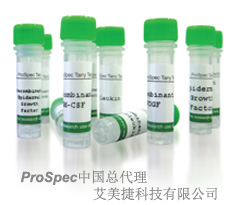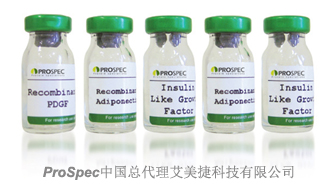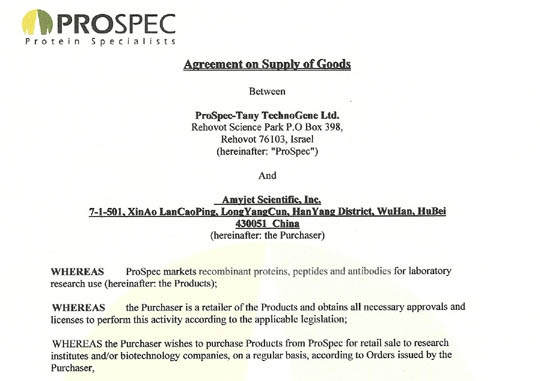
Catalogue number
ANT-154
Introduction
Heparanase is an endo-β-D-glucuronidase, which degrades heparan sulfate side chains of heparan sulfate proteoglycans (HSPGs) in the extracellular matrix. Heparanase plays an important role in ECM degradation, facilitating the migration and extravasation of tumor cells and inflammatory leukocytes (1,2,3). Upon degradation, heparanase releases growth factors and cytokines that stimulate cell proliferation and chemotaxis (4,5). Heparanase is a heterodimer comprised of a 50 kDa subunit harboring the active site and a 8 kDa subunit. It is produced as a latent 65 kDa precursor and proteolytically processed to its active form (1,6). Heparanase is highly expressed in myeloid leukocytes (i.e. neutrophils) in platelets and in human placenta. Human heparanase was found to be upregulated in various types of primary tumors, correlating in some cases with increased tumor invasiveness and vascularity and with poor prospective survival (7,8).
Source
Mab HP3/17 is a Protein G affinity purified monoclonal antibody raised against a polypeptide from the 50 kDa subunit of Heparanase.
Ig Subclass
Mouse IgG2Bκ
Formulation
Each vial contains 50, 100 or 150 μg in 14, 28 or42 μl respectively, of 0.22 micron filtered solution of 20 mM Sodium Phosphate; 150 mM NaCl; pH 7.2, containing 0.01% Thimerosal.
Applications
Western blotImmunohistochemistry
Specificity
HP3/17 reacts with the 50 kDa subunit and with the 65 kDa precursor of human or mouse Heparanase by Western blotting and immunohistochemistry.Recommended dilution range for Western blot analysis: 1:4000.Recommended dilution range for immunohistochemistry: 1:40.
Purity
>98% on SDS-PAGE when loaded 50 μg/lane.
Stability
Store at 4°C. Stable for six months from the date of shipment. For extended storage, freeze in working aliquots at -20°C. Avoid repeated freeze-thaw cycles.
Patent Protected Countries
Anti-heparanase antibodies and their uses, including HP3/17 and its uses, are protected by US. Patents No. 6,177,545; 6,531,129, additional US patent applications and patents and patent applications worldwide.
References
1. I. Vlodavsky, Y. Friedmann, M. Elkin, H. Aingorn, R. Atzmon, R. Ishai-Michaeli, M. Bitan, O. Pappo, T. Peretz, I. Michal, L. Spector, I. Pecker. 1999. Mammalian heparanase: gene cloning, expression and function in tumor progression and metastasis. Nat. Med. 5: 793–802.2. I. Vlodavsky, Y. Friedman. 2001. Molecular properties and involvement of heparanase in cancer metastasis and angiogenesis. J. Clin. Invest. 108: 341–347.3. C.R. Parish, C. Freeman, M.D. Hulett. 2001. Heparanase: a key enzyme involved in cell invasion. Biochem. Biophys. Acta 1471: M99–M108.4. I. Vlodasvsky, G. Korner, R. Ishai-Michaeli, P. Bashkin, R. Bar-Shavit, Z. Fuks, 1990. Extracellular matrix-resident growth factors and enzyme: Possible involvement in tumor metastasis and angiogenesis. Cancer Metastasis Rev. 9: 203-226.5. P. Bashkin, S. Doctrow, M. Klagsbrun, C.M. Svahn, J. Folkman, I. Vlodavsky. 1989. Basic fibroblast growth factor binds to subendothelial extracellular matrix and is released by heparitinase and hprn-like molecules. Biochemistry 28: 1737-1743.6. M.B. Fairbanks, A.M. Mildner, J.W. Leone, G.S. Cavey, W.R. Mathews, R.F. Drong, J.L. Slightom, M.J. Bienkowski, C.W. Smith, C.A. Bannow, R.L. Heinrikson. 1999. Processing of the human heparanase precursor and evidence that the active enzyme is a heterodimer. J. Biol. Chem. 274: 29587– 29590.7. A. Koliopanos, H. Friess, J. Klee., X. Shi, Q. Liao, I. Pecker, I. Vlodavsky, A. Zimmermann, M.W. Buchler. 1992. Heparanase expression in primary and metastatic pancreatic cancer. Cancer Res. 61: 4655–4659.8. K. Gohji, H. Hirano, M. Okamoto, S. Kitazawa, M. Toyoshima, J. Dong, Y. Katsuoka, M. Nakajima. 2001. Expression of three extracellular matrix degradative enzymes in bladder cancer. Int. J. Cancer 95: 295–301.
Data Sheet
To view the FULL VERSIONclick Here:
Safety Data Sheet
SDS
Usage
ProSpec"s products are furnished for LABORATORY RESEARCH USE ONLY. The product may not be used as drugs, agricultural or pesticidal products, food additives or household chemicals.
ProSpec是一家全球著名细胞因子蛋白及相关抗体生产和研发品牌。ProSpec的生产和研发工厂位于以色列,专注于蛋白(重组及合成)生产研发,其独有的细菌和哺乳动物表达和蛋白折叠技术使其能在17年内成长为国际一流的科研级蛋白供应商。目前ProSpec可以提供细胞因子,生长因子,激素,信号蛋白,病毒抗原等近800种重组蛋白和100多种抗体,是世界上提供蛋白品种最多的公司之一,领先的生产工艺和规模使其可以提供毫克到克级蛋白,价格优于同类公司。绝大部分产品是天然成熟型蛋白,而不含有标签蛋白。考虑到大部分研究者希望能更灵活地配制蛋白溶液,ProSpec-Tany绝大部分产品没有添加保护剂或盐,这就对工艺提出了更高的要求。同时,ProSpec-Tany绝大部分产品为冻干粉,因此易于运输和保存。
ProSpec的生产和研发工厂位于以色列雷霍沃特(Rehovot),专注于蛋白(重组及合成)生产研发。目前ProSpec可以提供细胞因子,生长因子,激素,信号蛋白,病毒抗原等近800种重组蛋白和100多种抗体,是世界上提供蛋白品种最多的公司之一,领先的生产工艺和规模使其可以提供毫克到克级蛋白,价格优于同类公司。 欢迎各位ProSpec客户及合作伙伴拨打全国免费电话400-6800-868转801/802/803垂询蚂蚁淘科技问询相关产品及解决方案! 代理ProSpec细胞因子、生长因子、激素、病毒抗原等重组蛋白产品简介 为便于客户选购ProSpec公司的各种重组蛋白,特将选购及使用注意事项列举如下: 1、需要考虑细胞因子、生长因子的种属来源和表达细胞选择 ProSpec可以提供多种不同种属来源的细胞因子等重组蛋白,如白介素-3,可以提供人白介素-3、小鼠白介素-3、大鼠白介素-3;而瘦蛋白Leptin则有人源、小鼠源、大鼠源、绵羊源、猪源、河豚源、马源、鸡源、狗源、兔源等十多种不同Leptin。蚂蚁淘科技推荐,建议按照作用的细胞选择相同种属的细胞因子。不过不同种属之间,蛋白同源性(序列一致性)在80%以上的基本上就可确定为有交叉活性,可推荐使用。另外,蚂蚁淘还可以向您提供ProSpec不同种属细胞表达的细胞因子,以重组人血管内皮生长因子(rVEGF)为例,ProSpec可以提供大肠杆菌表达的、酵母Yeast表达的、中国仓鼠卵巢CHO细胞、人胚肾HEK细胞表达的VEGF。可以根据您的实验需求,垂询蚂蚁淘科技有限公司为您推荐不同细胞表达的细胞因子产品。 2、ProSpec细胞因子的溶解和保存建议 ProSpec绝大部分细胞因子产品是天然成熟型蛋白,而不含有载体蛋白(CarrierProtein)或其他添加剂(如BSA、HAS或蔗糖等)。同时,ProSpec-Tany绝大部分产品通常以最少量的盐来进行冻干处理,因此易于运输和保存。所以我们建议在收到产品后,务必在开盖前先离心,使粘在管盖或管壁上的蛋白聚集于管底(此时能否见到白色沉淀均属正常现象)。为获得更好生物活性和保存稳定性,请联系蚂蚁淘科技垂询相关的溶解以保存建议。 领先的生产工艺和规模使其可以提供毫克到克级蛋白,价格优于同类公司,而小包装形式的细胞因子也受广大研究生客户喜爱。作为ProSpec的中国总代理,蚂蚁淘科技有限公司为客户精选真核细胞表达、高活性的几十多种常用现货ProSpec细胞因子。更多细胞因子产品请查询蚂蚁淘网站或垂询蚂蚁淘科技有限公司。 


ebiomall.com






>
>
>
>
>
>
>
>
>
>
>
>
说得简单点就是,细胞核是原封不动的,没有重组过,而细胞核外的东西是很多别的细胞中提取出来的并组合起来的。这样的混合体淋巴细胞产生的抗体具有很强的嵌合能力,针对性比一般的抗体强,但是它的来源没变,所以称之为混合单克隆抗体
制备抗体都需要进行纯化处理
清冷冻干燥后保存。
没有marker,怎么知道你做的蛋白大小?
没有参照物,怎么知道你跑的快不快?
没有尺子,怎么知道你的size大小?
凭嘴说吗?
单克隆抗体这项新技术从根本上解决了在抗体制备中长期存在的特异性和可重复性问题,可用于探讨: ①蛋白质的精细结构;②淋巴细胞亚群的表面新抗原;③组织相容性抗原;④激素和药物的放射免疫(或酶免疫)分析;⑤肿瘤的定位和分类;⑥纯化微生物和寄生虫抗原;⑦免疫治疗和与药物结合的免疫-化学疗法 (“导弹”疗法,利用单克隆抗体与靶细胞特异性结合,将药物带至病灶部位.。
因此,单克隆抗体可直接用于人类疾病的诊断、预防、治疗以及免疫机制的研究,为人类恶性肿瘤的免疫诊断与免疫治疗开辟了广阔前景。











